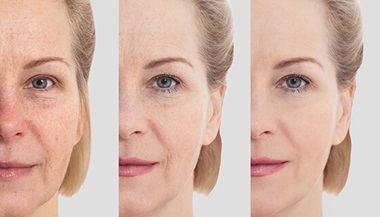Lip Lift, Lip Augmentation and Lip Reduction Surgery
Featured Expert
Lip plastic surgery can enhance a patient’s appearance by changing the shape of the lips. Reshaping procedures can make the lips larger or smaller or change their shape. One type, a lip lift, can make lips look fuller by shortening the distance between the lips and the bottom of the nose.
Dr. Shaun C. Desai, an associate professor of facial plastic and reconstructive surgery and chief of facial cosmetic surgery in the Johns Hopkins Department of Otolaryngology–Head and Neck Surgery, reviews what’s involved with a lip lift, lip augmentation and lip reduction surgery.
What You Need to Know
- A facial plastic surgeon can increase or decrease fullness in the lips or restore a more youthful appearance by performing a lip reshaping procedure.
- Procedures such as a lip lift may be performed in a plastic surgeon’s office with local anesthesia.
- Swelling after lip surgery can be significant, and may take two weeks or longer to resolve.
Lip Lift
A lip lift is a type of lip reshaping facial plastic surgery. As people age, the space between the nose and the mouth tends to become longer and the upper lip itself narrows and tucks under as the lower face sags. For patients who desire a fuller, more youthful look to their lips, a lip lift may have longer-lasting results than injectable fillers.
Types of Lip Lifts
- Corner lip lift: This lip plastic surgery corrects an upper lip that droops downward at the corners and makes a person look as if they are constantly frowning. The surgeon removes a small triangle of skin at each corner, gently guides the corners of the lip so they are no longer downturned and attaches the edges with tiny sutures. The procedure takes about 30 minutes and is performed with local anesthesia in the office.
- Bullhorn lip lift: This lip reshaping surgery, also called a subnasal lip lift, is performed by removing a horizontal crescent of skin (about 5 millimeters to 7 millimeters wide) just under the nose. This shortens the area above the upper lip and lifts the upper lip into a position where more of the pink area is visible and the curvature of the top of the upper lip, or “Cupid’s bow,” is more apparent. After this type of lip lift, more of the upper teeth show when the patient smiles.
What is the best age for a lip lift?
In the past, the procedure was recommended for people 55 and older, but new, refined techniques make it possible for people as young as 30 to have a lip lift.
How long does a lip lift last?
Unlike lip fillers, whose results fade within six to 12 months, lip lift results are permanent. However, with continued aging, the area between the nose and upper lip may resume drooping and lengthening over time. Some patients may desire a touch-up after five or more years.
Recovery After a Lip Lift
Pain after lip lift surgery is usually not severe and can be controlled with over-the-counter painkillers such as acetaminophen or naproxen.
Swelling persists for a week or more after any lip surgery and can be significant. Patients may have bruising on the lower part of the face. The doctor will suggest ways to keep swelling down, such as applying cold compresses. Patients should plan on limiting public activities for about two or three weeks.
As swelling recedes, results of the procedure become clearer, and the surgery’s effects become more apparent over the next several months as the incisions heal.
Lip Augmentation
People with thin or aging lips may want to make them fuller or larger. Cosmetic fillers are one solution, but the results are temporary, only lasting about six months to a year.
For more lasting lip augmentation, a plastic surgeon can insert an implant of manufactured material or the patient’s own skin or abdominal fat inside the lip.
What happens during lip augmentation?
Lip augmentation with implants can be performed in the office and takes about 30 minutes. The surgeon numbs your lips with local anesthetic and makes two incisions, one on each corner of your mouth. After creating a tunnel under the skin of the lips between the fat and the muscle, the surgeon grasps the end of the flexible implant with a delicate clamp inserted into the tunnel and pulls the implant into position. Tiny sutures (stitches) close the incisions. The results are permanent.
How can my skin be used in lip augmentation?
The surgeon can use tissue from your body to augment your lips. Using tissue from one part of your body to reshape another is called an autologous transfer. These procedures typically take between 60 and 90 minutes.
For instance, a piece of skin can be used to create an implant. The skin can be harvested from the lower abdomen, sometimes using the skin of an abdominal scar (such as a Cesarean section scar) or skin left over from performing a face-lift . After removing the epidermis layer of the piece of skin, leaving the dermis, the surgeon rolls the dermis into a cylinder shape and inserts it into the lip. The results can last five years or more.
Fat grafting uses fat from the belly, which is cleaned and injected into the lips to make them fuller. The surgeon uses local numbing to harvest fat from around the navel. After the fat is purified, the surgeon injects it into the lips like a filler. The results can last several years.
Recovery After Lip Augmentation
Like lip lifts, pain after lip augmentation is usually not severe and can be controlled with over-the-counter painkillers such as acetaminophen or naproxen.
Swelling persists for a week or more after any lip surgery and can be significant. Patients may have bruising on the lower part of the face. The doctor will suggest ways to keep swelling down, such as applying cold compresses. Patients should plan on limiting public activities for about two or three weeks.
As swelling recedes, results of the procedure become clearer, and the surgery’s effects become more apparent over the next several months as the incisions heal.
Lip Reduction Surgery
Some patients want to reduce the volume and fullness of their lips so their mouth is more in harmony with other facial features. In cases where the lips are extremely large, the patient may experience problems smiling, eating and speaking. Lip reduction cheiloplasty reduces the bulk of the lips while taking steps to help preserve their function and sensation.
What happens during lip reduction surgery?
The procedure is fairly simple, takes about 45 minutes and is done with local anesthesia. After injecting a numbing agent, the surgeon makes an incision inside the upper or lower lip and removes a strip of tissue from inside the lip, then closes the incision with tiny sutures. One or both lips may be reduced.
Recovery After Lip Reduction Surgery
Like other lip reshaping procedures, pain after lip reduction is usually not severe and can be controlled with over-the-counter painkillers such as acetaminophen or naproxen.
For incisions inside the mouth, which are made during lip reduction, the doctor may suggest a liquid diet for several days to allow the surgical area to heal.
Swelling persists for a week or more after any lip surgery and can be significant. Patients may have bruising on the lower part of the face. The doctor will suggest ways to keep swelling down, such as applying cold compresses. Patients should plan on limiting public activities for about two or three weeks.
As swelling recedes, results of the procedure become clearer, and the surgery’s effects become more apparent over the next several months as the incisions heal.
Consulting a Plastic Surgeon for a Lip Reshaping
For the best results, consult with a plastic surgeon who specializes in facial plastic surgery and who has experience in reshaping lips.
When you visit the surgeon, he or she will ask you about factors that could affect your results or recovery, including your history of:
- Smoking
- Heart or vascular disease
- Diabetes
- High blood pressure
- Thyroid disease
- Blood-clotting problems
- Any unusual scarring
The surgeon will review your age and skin type, explore your goals and expectations regarding aesthetic facial plastic surgery, and explain what is reasonable to expect in terms of results.
If you and the surgeon agree that a lip procedure is an appropriate option, the next steps are determining:
- Which lip reshaping procedure is most likely to achieve your desired results
- The location and timing of your procedure
- Possible lip reshaping complications
- Other recommended procedures
Facial Plastic and Reconstructive Surgery
The Johns Hopkins Center for Facial Plastic and Reconstructive Surgery brings together a team of experienced facial plastic surgeons committed to world-class facial cosmetic surgery, facial reconstruction and rehabilitation.






